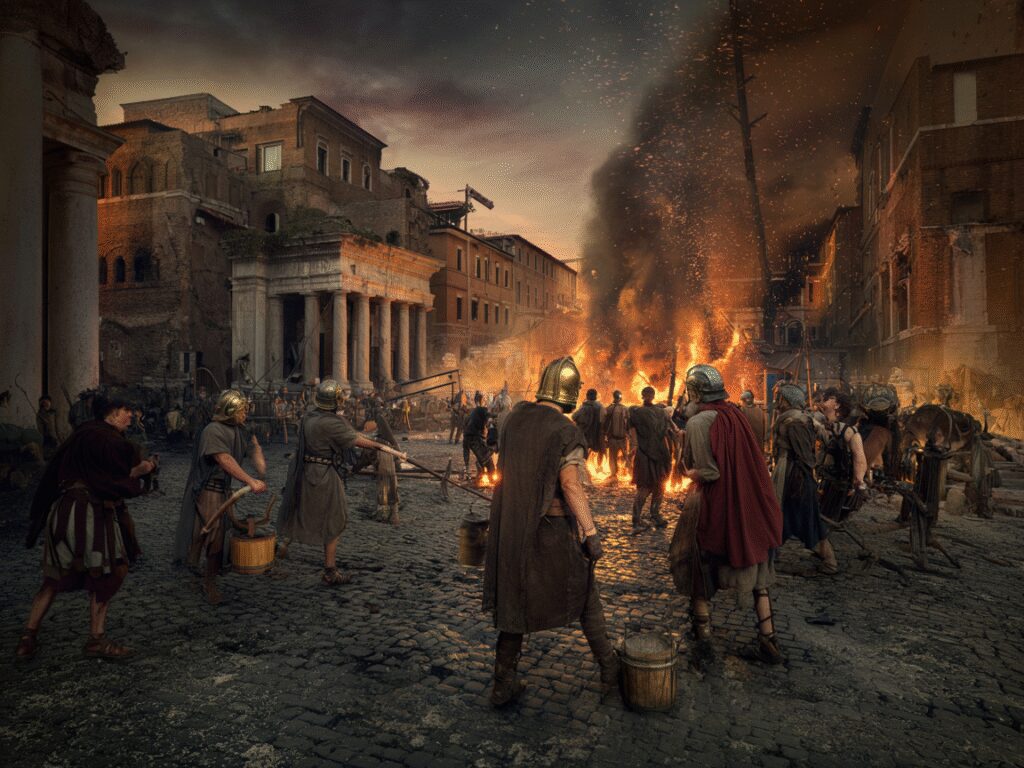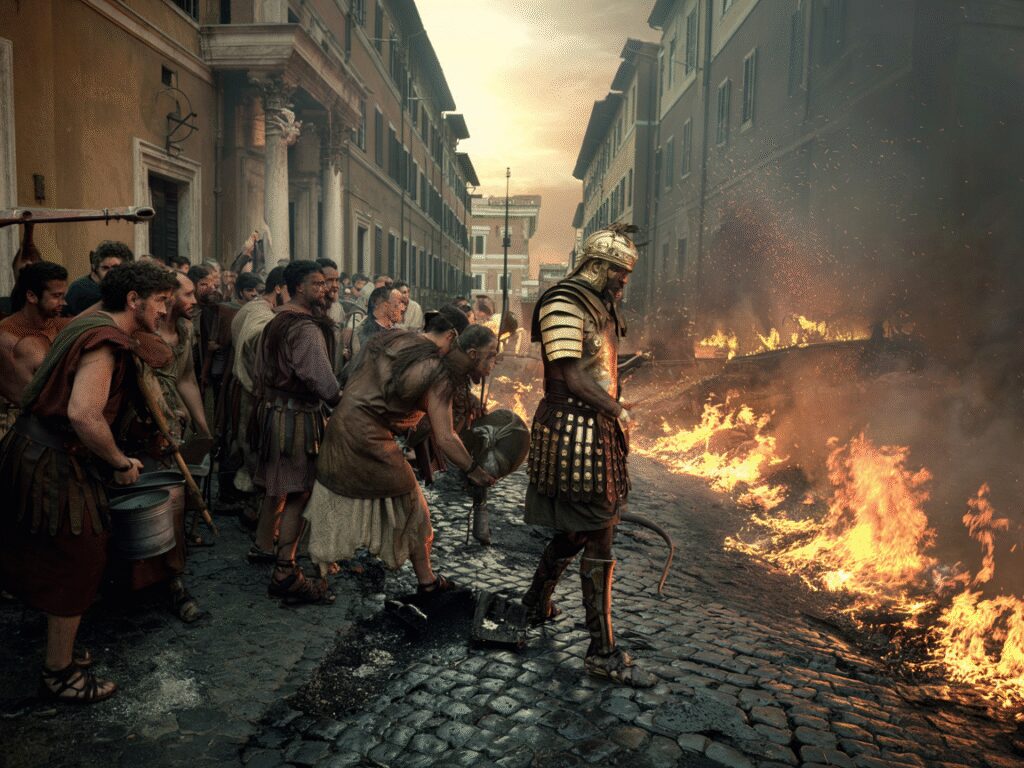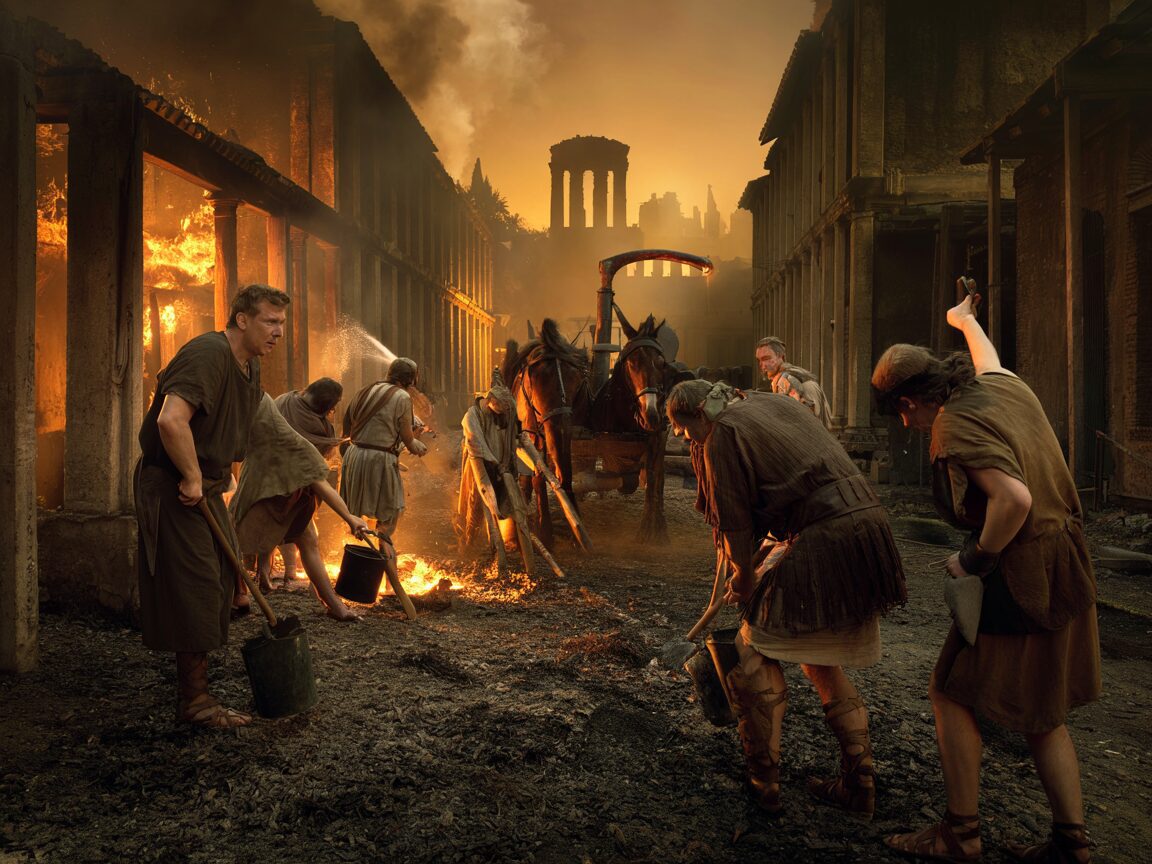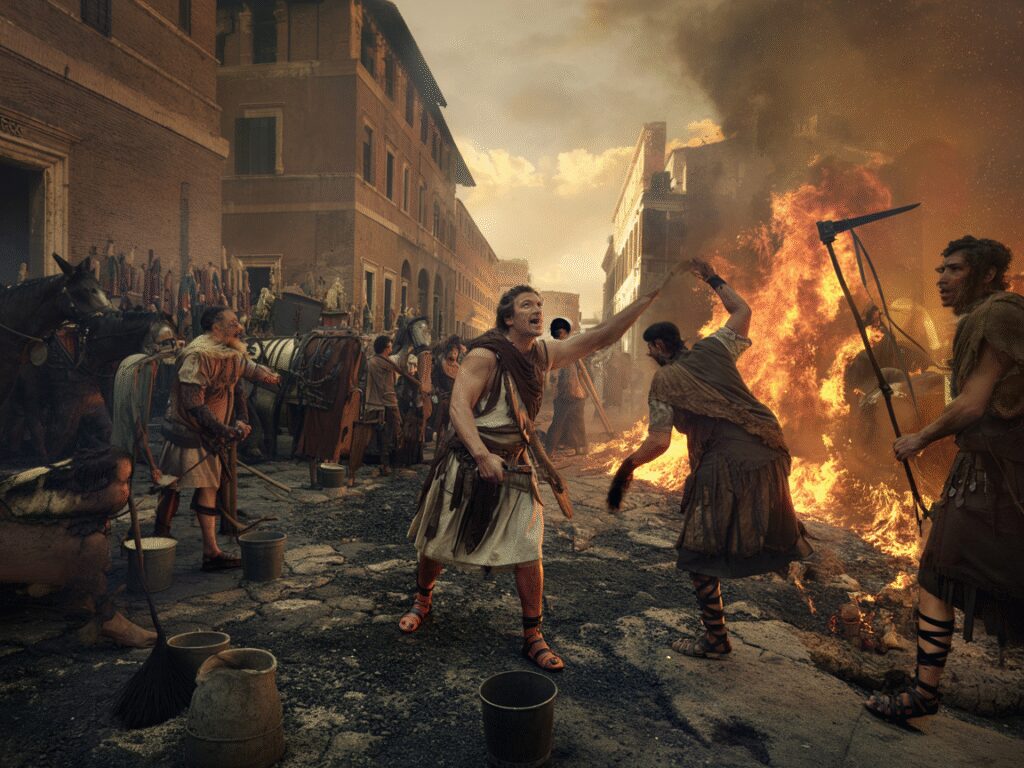The Vigiles were ancient Rome’s firefighters and police force, forming the backbone of the city’s emergency response system. As one of the earliest organized fire brigades, these Roman firefighters were crucial in a city where tightly packed wooden buildings made fire a constant and deadly threat.
Fire safety mattered deeply in ancient Rome. Fires could easily sweep through neighborhoods, causing devastation and loss of life. The Vigiles not only fought flames but also patrolled the streets to maintain order during the night and prevent crime.
However, their duties extended beyond just firefighting and policing. The Romans had a deep-seated belief system that influenced every aspect of their lives, including their approach to safety and order. This is evident in the rituals and sacrifices they performed to appease their multitude of gods, which were often seen as integral to maintaining peace and safety within the community.
Moreover, understanding the broader context of trade and economy in ancient Rome provides insights into how economic factors influenced urban safety measures. The specialized force of the Vigiles combined firefighting with policing duties, employed innovative techniques, and enforced strict safety regulations to protect Rome from disaster. Their legacy offers valuable lessons on urban safety that resonate even today.

Origins and Establishment of the Vigiles
The Cohortes Vigilum were founded by Emperor Augustus around AD 6, marking a significant development in Rome’s approach to urban safety. Before their formation, fire outbreaks frequently devastated the city, exacerbated by densely packed wooden buildings and narrow streets. The absence of a dedicated firefighting force left Rome vulnerable to widespread destruction.
Augustus established the Vigiles as a permanent fire brigade tasked with rapid response and prevention. This initiative responded directly to the need for organized fire control and maintaining public order during emergencies. The corps was structured into seven cohorts, each responsible for two of Rome’s fourteen regions.
Each cohort comprised roughly 1,000 men, predominantly freedmen, creating a force of approximately 7,000 firefighters and watchmen. This size allowed for continuous coverage throughout the city day and night. The strategic organization under Augustus laid the foundation for effective firefighting and policing in ancient Rome.
Organization and Structure of the Vigiles
The Vigiles were organized into seven cohorts, each tasked with overseeing fire and public order in two of Rome’s fourteen city regions. This division allowed for efficient coverage across the sprawling urban landscape, enabling rapid response to emergencies in specific districts.
Each cohort consisted mainly of freedmen firefighters—former slaves who had been granted freedom. Their recruitment reflected the social dynamics of ancient Rome, providing these men with a vital civic role while integrating them into structured military-style units known as Roman cohorts. This composition underscored the practical use of freedmen for essential public services.
Leadership rested with the Praefectus Vigilum, an equestrian officer appointed directly by the emperor. This official held supreme command over all cohorts, coordinating operations, discipline, and strategic deployment throughout the city. The Praefectus Vigilum ensured that firefighting efforts and policing duties were carried out effectively under imperial authority.
The role of such officials was crucial not only in maintaining public order but also in preserving the cultural integrity of Rome, which was reflected in its art and religion. For instance, the evolution of Roman sculpture captured realism and power, serving as instruments for political propaganda and religious devotion. Additionally, the Roman pantheon, a diverse collection of gods and goddesses worshipped in ancient Rome, reflects the values, beliefs, and customs that influenced the lives of its people.

Firefighting Tools and Techniques Used by the Vigiles
Roman firefighters relied on a variety of ancient firefighting equipment designed for efficiency in the densely packed urban environment. Their basic arsenal included:
- Buckets for hauling water, often passed hand-to-hand in human chains
- Sponges and brooms to extinguish smaller flames and clear debris
- Hooks and axes to tear down burning structures or create openings for ventilation
A significant technological advancement was the use of water pumps called sipho, horse-drawn devices capable of delivering water under pressure. This innovation boosted their ability to combat larger fires more effectively than buckets alone.
The Vigiles also employed ballistae, artillery usually reserved for warfare, repurposed to create firebreaks. By demolishing buildings ahead of advancing flames, they prevented fire from spreading further through Rome’s crowded neighborhoods.
These tools combined manual labor with engineering creativity, illustrating how Roman firefighters adapted both physical effort and technology to save the city from disaster. Interestingly, the power dynamics during such disasters were often reflected in the currency of the time. Coins served as more than just a means of trade; they became powerful tools for emperors to convey authority and legitimacy, acting as significant instruments for political messaging. This concept of coins as propaganda illustrates how even in times of crisis, the currency used held deeper meanings and implications.
The Multifaceted Role of the Vigiles Beyond Firefighting
The Vigiles were not just firefighters; their responsibilities extended deeply into maintaining law and order in Rome. They performed essential night watchmen duties, patrolling the streets after dark to keep peace in a city known for its rowdy and sometimes dangerous nightlife. These patrols helped deter violence and disorder, making the Vigiles a critical presence in urban safety.
Their role as slave hunters was equally significant. Runaway slaves posed a constant challenge to Roman society, and the Vigiles were tasked with tracking down and capturing those attempting to escape servitude. This function highlighted their unique position at the intersection of public security and social control.
Controlling petty crimes formed another pillar of their work. Theft, brawls, and disturbances on the streets required immediate attention—duties that blurred the lines between firefighting and policing. In this way, the Vigiles served as an early form of law enforcement in Rome, combining crime prevention with emergency response.
The dual role of the Vigiles — as firefighters and urban police — made them indispensable to the functioning of Rome’s complex social fabric. Their presence reassured citizens that help was available not only against flames but also against threats to public safety.

Fire Prevention Measures and Safety Regulations Enforced by the Vigiles
The Vigiles played a crucial role in enforcing Roman fire prevention laws that aimed to reduce the frequency and severity of fires in the densely populated city. One of their primary responsibilities was ensuring that private homes and businesses possessed adequate firefighting equipment. This included maintaining buckets, hooks, and ladders readily available for immediate use during an emergency.
Strict regulations required property owners to comply with these standards. Failure to equip homes properly or to maintain fire safety practices could result in severe penalties. The Vigiles were empowered to impose fines or other punishments on those found negligent, emphasizing accountability in fire prevention.
Their proactive approach extended beyond enforcement:
- Conducting regular inspections of residential and commercial districts
- Educating citizens on fire hazards and proper precautions
- Monitoring activities that posed high risk, such as open flames or careless storage of flammable materials
Through these measures, the Vigiles worked not only to extinguish fires but also to minimize their occurrence. Their vigilance helped create a culture of awareness around fire safety, critical in a city where wooden structures and crowded streets made fires particularly devastating.
By combining regulation, education, and enforcement, the Vigiles established one of the earliest examples of organized urban fire prevention efforts.
Strategic Deployment and Operations of the Vigiles in Ancient Rome
The Vigiles barracks locations were carefully distributed across Rome and its suburbs to ensure swift emergency response. Each of the seven cohorts was stationed in strategically placed barracks, enabling firefighters to reach incidents quickly. This network of posts allowed the Vigiles to cover the city’s vast and densely populated areas effectively.
Key features of their deployment included:
- Proximity to high-risk zones: Barracks were positioned near densely built neighborhoods where fire hazards were greatest due to wooden structures and narrow streets.
- Coverage of suburban districts: Outlying areas received attention to prevent fires from spreading inward toward the city center.
- Rapid mobilization: Being close to their patrol zones meant the Vigiles could respond within minutes, critical for minimizing damage.
During emergencies, coordination among cohorts was vital. The Praefectus Vigilum directed efforts using a command structure that balanced local autonomy with centralized control. When a fire broke out, Vigiles would:
- Mobilize quickly from multiple barracks
- Establish firebreaks by demolishing buildings if necessary
- Use water pumps and manual tools collaboratively
- Patrol surrounding areas to prevent flare-ups or looting
This operational strategy reflects how Roman Firefighters: How the Vigiles Saved the City from Disaster was not just dependent on manpower but also on intelligent placement and organized response systems designed to contain fires efficiently before they overwhelmed entire neighborhoods.

The Great Fire of Rome (AD 64) and How the Vigiles Responded to It
The Great Fire of Rome 64 AD stands as one of the most catastrophic events in ancient Roman history. During Emperor Nero’s reign, the Vigiles faced an unprecedented challenge. The fire erupted in the densely packed wooden neighborhoods, spreading rapidly through Rome’s fourteen districts. Despite their training and equipment, the Vigiles were overwhelmed by the scale and intensity of the blaze.
Key aspects of the Vigiles’ role during the Great Fire include:
- Rapid mobilization: The seven cohorts sprang into action to contain flames, employing buckets, pumps (sipho), and demolishing buildings with ballistae to create firebreaks.
- Coordination under pressure: Leadership from the Praefectus Vigilum focused on organizing efforts across multiple fronts amid chaos.
- Maintaining order: While combating the fire, Vigiles patrolled streets to prevent looting and violence.
Challenges arose when accusations surfaced claiming some Vigiles took advantage of the disorder to loot properties instead of fighting fires. Historical accounts vary, with some suggesting these claims were exaggerated or politically motivated to shift blame away from Nero’s administration. This reflects a broader trend during this period, where political instability and weak leadership plagued Rome, undermining its effectiveness in crisis management.
Despite these controversies, Nero’s reign firefighters demonstrated a remarkable commitment to limiting destruction under dire circumstances. Their actions helped save portions of Rome that might otherwise have been lost entirely.
The Great Fire underscored the vital importance of organized firefighting forces like the Vigiles in safeguarding sprawling urban centers vulnerable to rapid conflagrations.
The Legacy Left Behind by Roman Firefighters: Lessons From The Past For Modern Cities
The Vigiles set foundational standards in ancient urban safety that echo through the centuries. Their model of combining firefighting with policing duties influenced the development of later emergency response systems across Europe and beyond. This dual role allowed for a more comprehensive approach to disaster prevention Rome struggled with, addressing both immediate fire threats and the social conditions that could exacerbate crises.
Key aspects of their legacy include:
Institutionalizing permanent fire brigades: Before the Vigiles, firefighting was often ad hoc and volunteer-based. The establishment of a dedicated corps demonstrated the importance of continuous readiness and professional organization.
Integration of law enforcement and firefighting functions: By merging these roles, the Vigiles ensured rapid response not only to fires but also to disturbances that could hinder emergency efforts. Modern urban safety agencies often reflect this integrated approach—a concept deeply rooted in the enduring legacy of Roman law, which has significantly shaped modern legal systems.
Strategic deployment and regulation enforcement: The placement of barracks throughout Rome ensured fast action, a principle still vital in city planning today. Their proactive safety regulations helped minimize risks before disasters struck.
The Vigiles provide a historical blueprint for managing urban hazards effectively. Their example shows how structured coordination, preventive measures, and combined responsibilities can protect complex cities from disaster—lessons still relevant in contemporary disaster management strategies. This historical context also underscores the broader influence of Roman society on Western civilization, highlighting how their intricate social structures and innovative ideas laid the groundwork for many aspects of modern life.

Conclusion
The Vigiles played a crucial role in ancient Rome disaster prevention, serving as both firefighters and enforcers of public order. Their quick responses to fires, strategic use of technology, and strict regulations greatly reduced the constant threat of urban fires. More than just a firefighting force, they represented a comprehensive approach to city safety that combined emergency response with policing duties.
You can see a direct connection between the Vigiles’ groundbreaking efforts and today’s modern emergency services. Understanding their significance provides valuable insight into how ancient innovations influenced current disaster management systems.
See the Vigiles not only as historical figures but as pioneers whose legacy continues every time emergency personnel rush to protect lives and property.
Reflect on how far emergency services have come by considering the foundations laid by these Roman firefighters. Their story serves as a powerful reminder that protecting communities requires both watchfulness and creativity—principles that are still crucial today.
FAQs (Frequently Asked Questions)
Who were the Vigiles in ancient Rome and what roles did they serve?
The Vigiles were ancient Rome’s firefighters and police force, established to protect the city from fires and maintain public order. They served a dual role, combining firefighting duties with law enforcement tasks such as night patrols and slave hunting.
When and why were the Vigiles established in Rome?
The Vigiles were founded around AD 6 under Emperor Augustus to create a permanent fire brigade in Rome. Their establishment addressed the urgent need for organized fire safety measures to prevent devastating urban fires.
How was the organization and structure of the Vigiles designed?
The Vigiles were divided into seven cohorts, each responsible for two city regions. The corps was primarily composed of freedmen, reflecting Roman social dynamics, and was led by the Praefectus Vigilum, an official appointed by the emperor.
What tools and techniques did the Vigiles use to combat fires?
The Vigiles used various firefighting equipment including buckets, sponges, brooms, hooks, axes, horse-drawn water pumps called sipho, and innovative methods like using ballistae to demolish buildings creating firebreaks to control fire spread.
How did the Vigiles contribute beyond firefighting in ancient Rome?
Beyond fighting fires, the Vigiles performed night watchman duties to maintain public order on violent streets, hunted runaway slaves, controlled petty crimes, and enforced fire prevention regulations throughout the city.
What is the legacy of the Roman Vigiles for modern firefighting and urban safety?
The Roman Vigiles influenced later firefighting organizations and urban policing systems by integrating firefighting with law enforcement. Their proactive disaster prevention strategies serve as an early model for modern emergency services and urban safety management.

